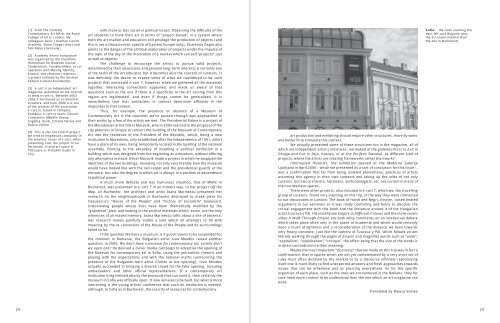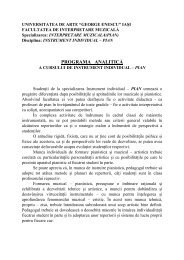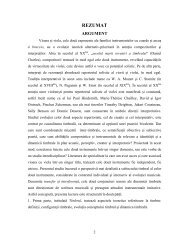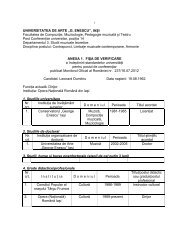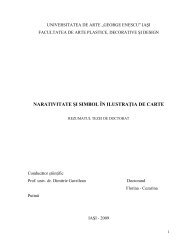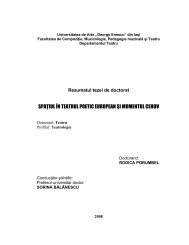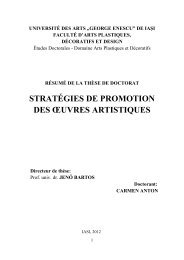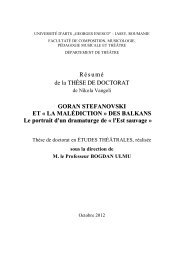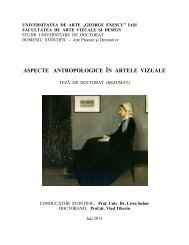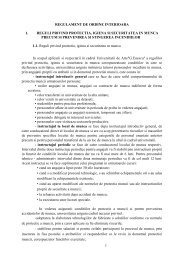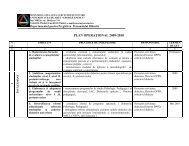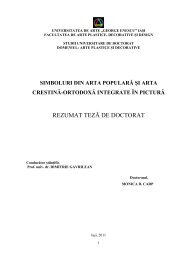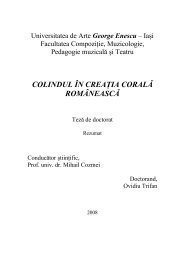vector 2_1.cdr - Universitatea de Arte "George Enescu"
vector 2_1.cdr - Universitatea de Arte "George Enescu"
vector 2_1.cdr - Universitatea de Arte "George Enescu"
Create successful ePaper yourself
Turn your PDF publications into a flip-book with our unique Google optimized e-Paper software.
24<br />
[1] From the Curating<br />
Contemporary Art MA at the Royal<br />
College of Art in London. My<br />
colleagues were: Jonathan Carroll<br />
(Ireland), Elena Crippa (Italy) and<br />
Tobi Maier (Germany).<br />
[2] Aca<strong>de</strong>my Remix symposium<br />
was organized by the Staatliche<br />
Hochschule für Bil<strong>de</strong>n<strong>de</strong> Künste -<br />
Stä<strong>de</strong>lschule, Frankfurt/Main, in cooperation<br />
with Missing I<strong>de</strong>ntity,<br />
Kosovo, and relations (relations -<br />
a project initiated by the German<br />
Fe<strong>de</strong>ral Cultural Foundation).<br />
[3] e-cart is an in<strong>de</strong>pen<strong>de</strong>nt art<br />
magazine, published on the internet<br />
at www.e-cart.ro. Between 2003<br />
2006 it functioned as an informal<br />
structure, and from 2006 it is one<br />
of the projects of the association<br />
E-cart.ro, based in Câmpina,<br />
România. e-cart.ro team: Eduard<br />
Constantin, Mădălin Geana,<br />
Angelica Iacob, Simona Nastac and<br />
Raluca Voinea.<br />
[4] This is also the kind of project<br />
we tried to emphasize constantly in<br />
the previous issues of e-cart, when<br />
presenting CAA, the project of Lia<br />
Perjovschi, H.arta art space in<br />
Timişoara or Protokoll studio in<br />
Cluj.<br />
with more or less social or political issues. Observing the difficulty of the<br />
art stu<strong>de</strong>nts to think their art in terms of “project-based”, in a system where<br />
both the art market and education still privilege the production of objects (and<br />
this is not a characteristic specific of Eastern Europe only), Ekaterina Degot also<br />
points to the danger of the artificial elaboration of projects un<strong>de</strong>r the impulse of<br />
the topic of the day or the motivation of a market which can sell “projects” just<br />
as well as objects.<br />
The challenge to encourage the artists to pursue valid projects,<br />
<strong>de</strong>termined by their obsessions and genuine long-term interests is certainly one<br />
of the tasks of the art educator, but it becomes also the concern of curators. It<br />
was <strong>de</strong>finitely the <strong>de</strong>sire to expose some of what we consi<strong>de</strong>red to be such<br />
projects that motivated e-cart 7. However, when we gathered all the materials<br />
together, interesting connections appeared, and ma<strong>de</strong> us aware of that<br />
questions such as the one if there is a specificity to the art coming from this<br />
region are legitimated, and even if things cannot be generalised, it is<br />
nevertheless true that similarities in context <strong>de</strong>termine affinities in the<br />
responses to that context.<br />
Thus, for example, the presence or absence of a Museum of<br />
Contemporary Art in the countries we've passed through was approached in<br />
their works by a few of the artists we met. The Presi<strong>de</strong>ntial Palace is a project of<br />
the Macedonian artist Oliver Musovik, who in 2003 reacted to the proposal of the<br />
city planners in Skopje to convert the building of the Museum of Contemporary<br />
Art into the resi<strong>de</strong>nce of the Presi<strong>de</strong>nt of the Republic, which, being a new<br />
institution in Macedonia, only established after the in<strong>de</strong>pen<strong>de</strong>nce of 1991, didn't<br />
have a place of its own, being temporarily located in the building of the national<br />
assembly. Pointing to the absurdity of installing a political institution in a<br />
building which was <strong>de</strong>signed from the beginning as a museum, without offering<br />
any alternative instead, Oliver Musovik ma<strong>de</strong> a project in which he swapped the<br />
i<strong>de</strong>ntities of the two buildings, revealing not only very literally how the museum<br />
would have looked like with the red carpet and the presi<strong>de</strong>ntial guards at the<br />
entrance, but also the <strong>de</strong>gree in which art is always in a position of <strong>de</strong>pen<strong>de</strong>nce<br />
to political power.<br />
A much more <strong>de</strong>licate and less humorous situation, that of MNAC in<br />
Bucharest, was presented in e-cart 7 in an indirect way. In her project Off the<br />
Map. In Bucharest, the architect and artist Ioana Marinescu presented her<br />
research on the neighbourhoods in Bucharest <strong>de</strong>stroyed to make place for<br />
Ceausescu's “House of the People” and “Victory of Socialism” boulevard.<br />
Interviewing people whose lives have been dramatically modified by the<br />
“grandiose” plan, and looking in the archive materials which, some, are the only<br />
witnesses of an erased memory, Ioana Marinescu talks about a site of absence.<br />
Her research makes painfully visible a void which all attempts to fill with<br />
meaning by the re-conversion of the House of the People and its surroundings<br />
failed so far.<br />
If the question We have a museum, is it good? seems to be suspen<strong>de</strong>d for<br />
the moment in Romania, the Bulgarian artist Ivan Moudov raised another<br />
question, in 2005: We don't have a museum for contemporary art, so why don't<br />
we open one? He <strong>de</strong>vised a clever media campaign to advertise the opening of<br />
the Museum for contemporary art in Sofia. Using the journalistic rhetoric and<br />
playing with the expectations and with the national myths (announcing the<br />
presence of the Bulgarian-born artist Christo at the opening), Ivan Moudov<br />
actually succee<strong>de</strong>d in bringing a diverse crowd for the fake opening, including<br />
ambassadors and other official representatives. If a contemporary art<br />
institution is legitimised also by the protocols that surround it, then certainly the<br />
museum in Sofia was officially open. It now remains to be built, but what is more<br />
interesting is the young artists' confi<strong>de</strong>nce that such an institution is nee<strong>de</strong>d,<br />
although, in Sofia as in Bucharest, the scarcity of resources for contemporary<br />
art production and exhibiting should require other structures, more dynamic<br />
and better fit to stimulate this context.<br />
We actually presented some of these structures too in the magazine, all of<br />
which are in<strong>de</strong>pen<strong>de</strong>nt artist's initiatives: we looked at the galleries Press to Exit in<br />
Skopje and Exit in Peje, Kosovo, or at the Periferic Biennial, as different kind of<br />
4<br />
projects, where the artists are creating frameworks rather than works .<br />
Interrupted Histories, the exhibition opened at the Mo<strong>de</strong>rna Galerija<br />
Ljubljana in April 2006 - which we presented as a sort of conclusion for this issue -,<br />
was a confirmation that far from being isolated phenomena, practices of artists<br />
assuming this agency in their own contexts and taking up the roles of not only<br />
curators, but also archivists, historians, anthropologists, etc. are current in many of<br />
the non-Western spaces.<br />
There were other projects, also inclu<strong>de</strong>d in e-cart 7, which we, the travelling<br />
group of curators, found very inspiring on this trip, in the way they were connected<br />
to our discussions in London. The book of Hardt and Negri, Empire, raised heated<br />
arguments in our seminars so it was really conforting and funny to discover the<br />
critical engagement with this book and the literature around it of the Hungarian<br />
artist Szacsva y Pál. His installation Empire in Different Colours and the more recent<br />
vi<strong>de</strong>o A Walk Through Empire are both witty comments on an intellectual <strong>de</strong>bate<br />
which takes place often only in the space of aca<strong>de</strong>mia and which would certainly<br />
need a touch of lightness and a reconsi<strong>de</strong>ration of the distance we have towards<br />
very heavy concepts. Just like the camera of Szacsva y Pál, which follows an ant<br />
literally walking through the pages of Empire and magnifies words such as “work”,<br />
“capitalism”, “exploitation”, “critique”, the effect being that the size of the words is<br />
in direct contradiction to their meaning.<br />
Maybe the most important “discovery” that we ma<strong>de</strong> on this trip was in fact a<br />
confirmation, that in spaces which are not yet contaminated by a very strict set of<br />
rules most often dictated by the market or by a discourse infinitely reproducing<br />
itself one is more likely to find unexpected answers and fresh approaches towards<br />
issues that can be otherwise just as pressing everywhere. As for the specific<br />
urgencies of each place, such as the ones we encountered in the Balkans, they for<br />
sure need more context to be un<strong>de</strong>rstood than the one which an art magazine can<br />
build.<br />
Translated by Raluca Voinea<br />
Sofia - the clock counting the<br />
days left until Bulgaria joins<br />
the EU (more minimal than<br />
the one in Bucharest)<br />
25


